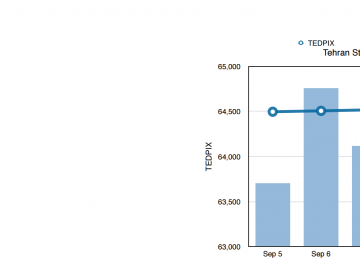Tehran Stock Exchange’s main index lost 809 points or 1.26% to close at 63,468 during the trading week that ended September 9, amid the reopening of several large-cap companies’ ticker symbols on the TSE board.
The prevailing recession, lack of liquidity and bleak prospect in the mid-run stoked concern among shaky investors, leading to massive selloff.
Bank Pasargad, Khouzestan Steel Company, Mobarakeh Steel Company, Telecommunications Company of Iran, Bandar Abbas Oil Refinery Company, Golgohar Mining and Industrial Company, Chadormalu Mining and Industrial Company, Parsian Oil and Gas Development Company, and Metals and Mines Development Investment Company were nine blue chips that saw their ticker symbols back on the board.
According to TSE data, the First Market Index plunged 837 points or 1.92% to end at 44,638. The Second Market Index ticked down 78 points or 0.06% to reach 137,606.
About 2.57 trillion shares changed hands valued at $131.14 million to record 17.7% and 49% decline in trade volume and value respectively compared to the prior trading week. The number of transactions increased by 21% however.
Leather, sugar, and printing and publishing companies were the leading weekly gainers, while producers of base metals and oil products were the biggest losers.
Notwithstanding the ongoing recession, which is draining the equity market, the low average PE ratios and shares’ rock-bottom prices provide investors with an opportunity to shore up their portfolios. However, in doing so, diversification and due diligence in analyzing the prospect of respective companies are greatly recommended in advance.
Moreover, another risk the stock market has been grappling with has been eliminated as US Senate Democrats delivered a major victory to President Barack Obama when they blocked a Republican resolution to reject a six-nation nuclear accord with Iran on Thursday, ensuring the landmark deal will take effect without a veto showdown between Congress and the White House, New York Times reported.
Once sanctions are lifted, millions of inflows will be poured into the country, which projects a bright future ahead. Hence the end of the lingering bear market seems within reach with stocks expected to jump to new highs in the near future.
IFX in Red
Iran Fara Bouse’s benchmark lost 9.9 points or 1.4% during the same week to settle at 723.
More than 1.84 million shares valued at $212.32 million traded to register 85% and 26% jump in trade volume and value respectively.
Weekly transactions plunged 1% and IFB’s market cap slipped 0.7% to stand at $23.21 billion.
The highlight of the week was IFB’s second Initial Public Offering this Iranian year (started March 21), which was filed for Lia Company with its shares priced at 1,360 rials each.





